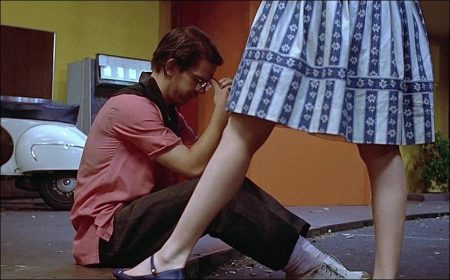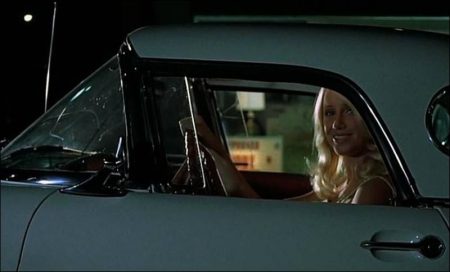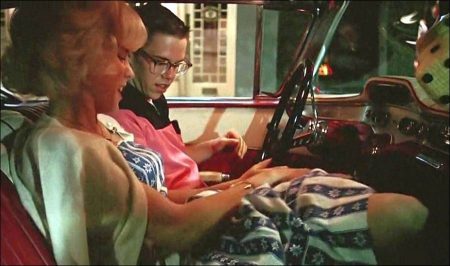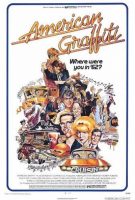Taglines: Where were you in ’62?
American Graffiti movie storyline. It’s the proverbial end of the summer 1962 in a small southern California town. It’s the evening before best friends and recent high school graduates, Curt Henderson and Steve Bolander, are scheduled to leave town to head to college back east.
Curt, who received a lucrative local scholarship, is seen as the promise that their class holds. But Curt is having second thoughts about leaving what Steve basically sees as their dead end town. Curt’s beliefs are strengthened when he spots an unknown beautiful blonde in a T-bird who mouths the words “I love you” to him.
As Curt tries to find that blonde while trying to get away from a local gang who have him somewhat hostage, Curt may come to a decision about his immediate future. Outgoing class president Steve, on the other hand, wants to leave, despite meaning that he will leave girlfriend, head cheerleader and Curt’s sister, Laurie Henderson, behind. Steve and Laurie spend the evening “negotiating” the state of their relationship.
Meanwhile, two of their friends cruise around town for the evening. Steve has left his car to meek and mild-mannered Terry “Toad” Fields to look after during his absence. The wheels give Toad a new sense of confidence, which he uses to try and impress Debbie Dunham, a more experienced girl generally out of his league. And John Milner, who is seen as the king of the street race in his souped-up yellow deuce coupe, tries to get rid of precocious pre-teen, Carol Morrison, who has somehow become his passenger for the evening, while dealing with the challenge of bold out-of-towner, Bob Falfa.
American Graffiti is a 1973 American coming-of-age comedy film directed and co-written by George Lucas starring Richard Dreyfuss, Ron Howard, Paul Le Mat, Harrison Ford, Charles Martin Smith, Cindy Williams, Candy Clark, Mackenzie Phillips, Bo Hopkins, and Wolfman Jack. Suzanne Somers, Kathleen Quinlan, Debralee Scott and Joe Spano also appear in the film.
Set in Modesto, California, in 1962, the film is a study of the cruising and early rock ‘n’ roll cultures popular among the early baby boomer generation. Through a series of vignettes, the film tells the story of a group of teenagers and their adventures over the course of a single night.
The genesis of American Graffiti was in Lucas’ own teenage years in early 1960s Modesto. He was unsuccessful in pitching the concept to financiers and distributors, but found favor at Universal Pictures after every other major film studio turned him down. Filming was initially set to take place in San Rafael, California, but the production crew was denied permission to shoot beyond a second day. As a result, production was moved to Petaluma.
American Graffiti premiered on August 2, 1973, at the Locarno International Film Festival in Switzerland, and was released on August 11, 1973, in the United States. The film received widespread critical acclaim and was nominated for the Academy Award for Best Picture. Produced on a $777,000 budget, it has become one of the most profitable films of all time.
Since its initial release, American Graffiti has garnered an estimated return of well over $200 million in box office gross and home video sales, not including merchandising. In 1995 the United States Library of Congress deemed the film “culturally, historically, or aesthetically significant” and selected it for preservation in the National Film Registry. A sequel, More American Graffiti, was released in 1979.
American Graffiti (1973)
Directed by: George Lucas
Starring: Richard Dreyfuss, Ronny Howard, Paul Le Mat, Charlie Martin Smith, Candy Clark, Mackenzie Phillips, Cindy Williams, Wolfman Jack, Jana Bellan, Harrison Ford, Mackenzie Phillips
Screenplay by: George Lucas, Gloria Katz, Willard Huyck
Cinematography by: Jan D’Alquen, Ron Eveslage
Film Editing by: Verna Fields, Marcia Lucas, George Lucas
Costume Design by: Aggie Guerard Rodgers
Set Decoration by: Douglas Freeman
Art Direction by: Dennis Lynton Clark
MPAA Rating: None.
Distributed by: Universal Pictures
Release Date: August 2, 1973 (Locarno), August 11, 1973 (United States)
Views: 343











